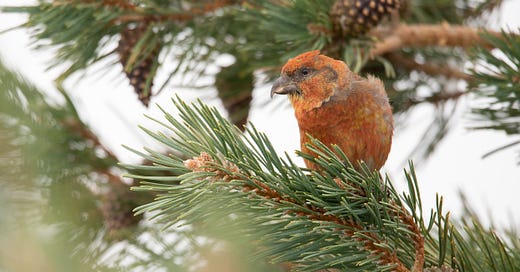Among the birdlife unique to the UK, the Scottish Crossbill holds a special place. As the only bird species endemic to Britain, it is found exclusively in the Caledonian pine forests of northern Scotland, a birdwatcher’s challenge and reward. Spotting this species is a distinctive experience, not just because of its rarity but also because of the nuanced identification required.
Scottish Crossbills are part of the crossbill family, birds known for their crossed mandibles, an adaptation that helps them extract seeds from conifer cones. They share this trait with the Common Crossbill and Parrot Crossbill, two species that also inhabit Scotland's forests. At first glance, they all look strikingly similar, with males displaying red or orange plumage, females appearing in shades of green or yellow, and juveniles showing streaky, more subdued patterns.
The key difference between these species, however, lies in their vocalizations. Scottish Crossbills have a distinct call—a subtle yet crucial characteristic for identification. Their calls are a unique 'chip-chip' that’s slightly lower in pitch than the Common Crossbill's sharper 'chit-chit' and less resonant than the Parrot Crossbill’s deeper call. Researchers, including the RSPB, have used sonograms to differentiate these species, analysing the frequency and structure of their calls.
If you’re serious about identifying a Scottish Crossbill, listening to its call is essential. Sound recording equipment can be helpful in analysing the calls later, allowing for more accurate identification than relying solely on visual clues.
Identifying the Scottish Crossbill in the field can be tricky, even for experienced birders. Size-wise, it sits between the Common and Parrot Crossbill, but these differences are often difficult to notice. While the Parrot Crossbill’s larger, more powerful bill can help distinguish it, separating a Scottish Crossbill from a Common Crossbill based on bill size alone is tough.
The real challenge lies in confirming your sighting with the bird’s call. Many birders train their ear to recognize the subtle differences, but even then, the variation can be minute. To complicate matters further, crossbills are highly nomadic, with individuals moving across large areas in search of food. This mobility means that Common and Parrot Crossbills also appear in the Scottish Highlands, adding to the difficulty of nailing down a Scottish Crossbill sighting.
Scottish Crossbills are closely tied to their habitat—the ancient pine forests of northern Scotland. The best places to search are the Scots pine woodlands of the Cairngorms, particularly in areas like Abernethy Forest and around the Speyside region. These birds primarily feed on Scots pine seeds, so they are usually found in areas with dense pine coverage.
Winter and early spring are ideal times for observation, as crossbills are actively foraging for seeds in the cooler months. With less foliage on the trees, spotting birds in the canopy becomes easier, and the scarcity of food elsewhere draws them into concentrated areas where pine cones are abundant. That said, they can be elusive, so persistence and patience are often required.
The Scottish Crossbill is more than just a rare species—it’s a testament to the unique biodiversity found in Scotland’s forests. Its elusive nature and the difficulty in identifying it make it a sought-after species for birdwatchers across the UK and beyond. Whether you’re an experienced birder or just beginning to explore the Highlands, searching for this bird offers a deeper connection to Scotland’s wild landscapes. As always, the key is in the details—listen closely, look carefully, and enjoy the challenge that comes with observing one of Britain’s most distinctive birds.
REMEMBER TO SUBSCRIBE!




